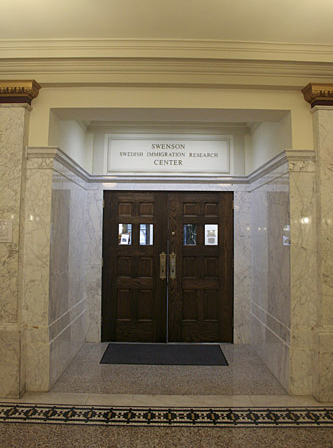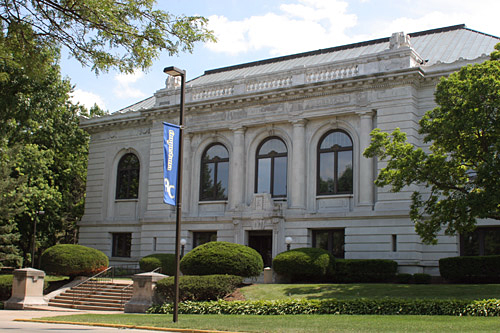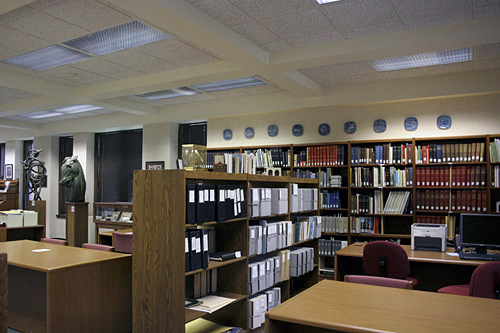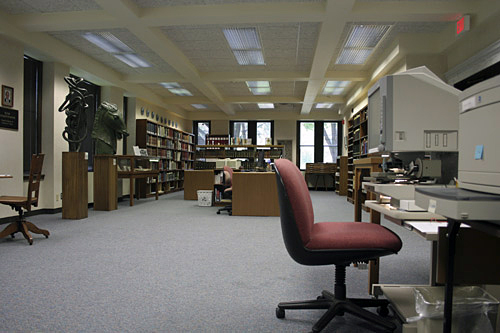Hunting Your Swedish Roots
Searching for Clues in Public Records in both Sweden and the United States.
-
 Swenson Immigration Research Center in Rock Island, Illinois.
Swenson Immigration Research Center in Rock Island, Illinois. -
-
Hunting Your Swedish Roots – Searching for Clues in Public Records
-
 Exterior of Denkmann Memorial Library, Augustana College.
Exterior of Denkmann Memorial Library, Augustana College. -
-
This article is part a series describing the hunt for one’s Swedish roots. Before one can jump the pond, one must know a Swedish ancestor’s name, parish of origin in Sweden and a significant date such as a birth date or emigration date.
In the first article we discussed the first step in the hunt is to look for personal sources. This includes interviewing family members and finding what information resides within your family, including such items as letters, family Bibles, diaries, photos and other personal memorabilia. If the search among personal sources was not fruitful, the next step is to search for clues in public records and American church records.
Civil public records such as U.S. and state census records, marriage and death certificates, applications for naturalization, newspaper obituaries, World War I and World War II draft registrations are sources that may help you find clues about your ancestor. Many of these records are now online. Many are available on subscriptions sites such as www.ancestry.com, and more records are being added to the free site https://www.familysearch.org. -
 The extensive library of Swenson Immigration Research Center.
The extensive library of Swenson Immigration Research Center. -
U.S Census records
Within the U.S. Census records, information will vary by the year. Census records for the years 1900, 1910, 1920 and 1930 include the immigration year. (Unfortunately, most of the 1890 U.S. Census records were destroyed.) The place the person emigrated from is usually just noted as Sweden. Most census records only give the person’s age but the 1900 U.S. Census gives the month and year of a person’s birth. This can be very helpful, although you can’t always rely on the accuracy of the U.S. census. The 1940 Census was released on April 2, and while indexing by name is not complete, browsing the records is possible. One can find a good guide for searching the 1940 Census records by going to httpps//www.stevemorse.org. This site includes articles on how to search within the 1940 census as well as search tools. -
 Work areas at Swenson Immigration Research Center.
Work areas at Swenson Immigration Research Center. -
State census records
Some states conducted state censuses and these records can be very helpful especially in the absence of the 1890 U.S. Census. Not all states conducted state censuses but if your ancestor immigrated to a state where censuses were conducted, such as Minnesota, you are in luck. Minnesota has state census records for 1865, 1875, 1885, 1895 and 1905. In addition to U.S. Census records, check for the existence of state census records. -
Vital records and obituaries
Marriage and death certificates may provide age information. Many of these records are online but this does vary by state. Obituaries often provide information about where in Sweden the emigrant came from as well as names of siblings who may have remained in Sweden. One might be able to find the place of origin by looking for the sibling in Swedish census records. -
Naturalization records
Often the application for naturalization gives very detailed information about the emigrant including birth date, place or origin within Sweden and even parents' names. For detailed information about how to find naturalization records, go to the National Archives website: https://www.archives.gov/research/naturalization/naturalization.html. -
Swedish-American church records
Many Swedish immigrants joined Swedish-American churches, primarily Lutheran but also other denominations such as Baptist, Swedish Covenant and Methodist. These churches kept very detailed records including the name of the parish in Sweden where the person was born.
Many of these Swedish-American church records have been microfilmed and are available at the Swedish Swenson Immigration Research Center in Rock Island, Illinois and the Swedish Emigrant Institute in Växjö, Sweden: https://www.swensoncenter.org
The amount of information depends upon individual congregations, but if the information is complete, these records often reveal the date and place of birth and baptism, date received as a church member and arrival year in America. -
Swedish-American newspapers
The Swenson Center also has many Swedish-American newspapers on microfilm. Many obituaries can be found in these newspapers. For a list of the newspapers that are on microfilm, visit the Swenson Center’s website: https://www.swensoncenter.org
Hopefully, by looking at U.S. records, one will be able to obtain an approximate age or birth information as well as an emigration date for an emigrant ancestor and with luck maybe the parish of origin in Sweden. But don’t give up if you haven’t found the place or origin; in the next article we will look at emigration records and Swedish census records. -
-
